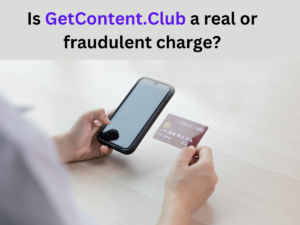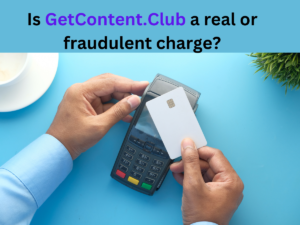In today’s digital age, where online subscriptions and services are ubiquitous, it’s not uncommon for consumers to encounter unfamiliar charges on their credit card or bank statements. One such charge that has raised questions and concerns among users is “GetContent.Club.” Many people have reported seeing this charge on their statements without recognizing the service or remembering signing up for it.
This has led to widespread speculation: Is GetContent.Club a legitimate service, or is it a fraudulent charge? In this article, we’ll delve into the details of GetContent.Club, explore user experiences, and provide guidance on how to handle such charges.
What is GetContent.Club?
GetContent.Club is an online platform that offers digital content, such as eBooks, articles, or other downloadable resources. According to its website, the service provides users with access to a library of content for a subscription fee. The platform markets itself as a convenient way to access valuable information and resources for personal or professional use.
However, the legitimacy of GetContent.Club has been called into question due to several factors:
Lack of Transparency: Many users report that they were unaware they had signed up for the service or were charged. This suggests that the sign-up process may not be clear or that users were enrolled without their explicit consent.
Difficulty Canceling Subscriptions: Some users have complained about the challenges of canceling their subscriptions or obtaining refunds, which is a common red flag for fraudulent or deceptive practices.
Vague Descriptions: The website and terms of service are often described as vague, making it difficult for users to understand what they are signing up for and how to manage their accounts.

User Experiences with GetContent.Club
To better understand whether GetContent.Club is a legitimate service or a fraudulent charge, it’s important to examine the experiences of users who have encountered this charge. Online forums, review sites, and social media platforms are filled with mixed reviews and complaints about GetContent.Club.
Positive Experiences
While the majority of feedback is negative, some users have reported positive experiences with GetContent.Club. These users claim to have found value in the content provided and were aware of the subscription terms when they signed up. For these individuals, the service appears to be legitimate and useful.
Negative Experiences
The vast majority of user feedback, however, is negative. Common complaints include:
- Unauthorized Charges: Many users report seeing a charge from GetContent.Club on their credit card or bank statement without recalling signing up for the service. This has led to suspicions of fraudulent activity or deceptive marketing practices.
- Hidden Terms: Some users claim that they were unknowingly enrolled in a subscription after signing up for a free trial or downloading a resource. The terms of the subscription were allegedly buried in fine print, making it easy to miss.
- Poor Customer Support: Numerous users have expressed frustration with the lack of responsive customer support. Attempts to cancel subscriptions or request refunds are often met with delays or ignored altogether.
- Difficulty Canceling: Even when users are aware of the subscription, many report difficulty canceling it. Some have had to contact their bank or credit card company to dispute the charges and block future payments.
Is GetContent.Club a Scam?
The question of whether GetContent.Club is a scam is not straightforward. While the service itself may not be inherently fraudulent, the practices associated with it have raised significant concerns. Here are some key points to consider:
Deceptive Marketing Practices
One of the primary reasons GetContent.Club is viewed with suspicion is its alleged use of deceptive marketing tactics. These include:
- Bait-and-Switch Tactics: Offering a free trial or downloadable resource in exchange for payment information, then automatically enrolling users in a subscription without clear disclosure.
- Hidden Fees: Failing to clearly communicate the cost of the subscription or the terms of the trial period, leading to unexpected charges.
- Lack of Transparency: Making it difficult for users to find information about the company, its terms of service, or how to cancel subscriptions.
Complaints and Legal Action
The volume of complaints about GetContent.Club has led to increased scrutiny. Some users have reported filing disputes with their banks or credit card companies to reverse the charges. In some cases, legal action has been taken against similar companies for deceptive practices, which raises questions about the legitimacy of GetContent.Club.
Legitimate but Misleading
It’s possible that GetContent.Club is a legitimate service that uses misleading or aggressive marketing tactics to attract users. While this doesn’t necessarily make it a scam, it does make it a service that consumers should approach with caution.

How to Handle a GetContent.Club Charge?
If you’ve noticed a charge from GetContent.Club on your statement and are unsure how to proceed, here are some steps you can take:
Review Your Records
Check your email and browser history to see if you signed up for a free trial or downloaded content from GetContent.Club. Sometimes, users forget about subscriptions they’ve signed up for, especially if they were part of a larger transaction.
Contact GetContent.Club
If you believe the charge is unauthorized, contact GetContent.Club directly to request a refund or cancel your subscription. Be prepared for potential challenges, as many users report poor customer service.
Dispute the Charge
If you’re unable to resolve the issue with GetContent.Club, contact your bank or credit card company to dispute the charge. Most financial institutions have processes in place to handle unauthorized or fraudulent charges.
Monitor Your Accounts
Keep a close eye on your bank and credit card statements for any additional charges. If you suspect fraudulent activity, consider placing a fraud alert on your accounts or freezing your credit.
Report the Charge
If you believe you’ve been the victim of a scam, report the charge to relevant authorities, such as the Federal Trade Commission (FTC) in the United States or your local consumer protection agency.
How to Avoid Unwanted Subscriptions?
To protect yourself from unwanted subscriptions and charges like those associated with GetContent.Club, follow these tips:
Read the Fine Print: Always read the terms and conditions before signing up for a free trial or downloading content. Look for information about automatic renewals and cancellation policies.
Use Virtual Cards: Consider using virtual credit cards or payment services that allow you to set spending limits or cancel recurring payments easily.
Monitor Your Statements: Regularly review your bank and credit card statements for unfamiliar charges. The sooner you catch an unauthorized charge, the easier it will be to resolve.
Be Cautious with Free Trials: Free trials often come with strings attached. If a service requires payment information for a free trial, be wary.
Use Strong Passwords: Protect your accounts with strong, unique passwords to prevent unauthorized access.
Conclusion
The question of whether GetContent.Club is a real or fraudulent charge is complex. While the service appears to offer legitimate content, the numerous complaints about unauthorized charges, deceptive marketing practices, and poor customer support suggest that consumers should approach it with caution. If you encounter a charge from GetContent.Club, take immediate steps to investigate and resolve the issue. By staying informed and vigilant, you can protect yourself from unwanted subscriptions and potential scams in the digital marketplace.
Ultimately, the burden of transparency and ethical practices lies with companies like GetContent.Club. Until they address the concerns raised by users, the debate over their legitimacy will continue. In the meantime, consumers must remain proactive in managing their online subscriptions and financial accounts to avoid falling victim to deceptive practices.
